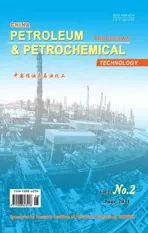SINOPEC Shanghai Research Institute of Petrochemical Technology Uses Key Morphology Parameter of ZSM-5 to Achieve Technology for Distributed Control and Tuning of Aromatics
2021-03-29
Recently, the research team of the SINOPEC Shanghai Research Institute of Petrochemical Technology (SRIPT)has made progress in studying the key morphology parameter of zeolite, which can influence the distribution of aromatics formed during the one-step conversion of syngas to aromatics (STA) reaction, while concurrently establishing the relationship between the substitution ratio of aromatic ring and the morphological parameters of zeolites. The related research achievements were published inACS Catalysis(October 2020).
In an oxide–zeolite bifunctional catalyst system, the STA reaction network is composed of multiple reactions including CO activation and hydrogenation, C-C coupling, aromatization, and alkylation of aromatic ring.It is a big challenge for this catalytic system to coordinate the equilibrium between each step of reaction aimed at attaining high aromatic selectivity in a bid to realize distributed tuning and control of aromatics.
The current research through screening and optimizing the oxides and zeolite components has realized a total aromatics selectivity of more than 70%. Judging from most existing research outcome, the C9+ heavy aromatics generally occupy a dominating ratio, while light aromatics such as benzene,toluene and xylene (BTX) with higher application value and market demand only account for 30%.
Upon decoupling the reaction which can be affected by the acidic sites of zeolite, the aromatization activity inside the channel and the aromatic ring alkylation activity on the outside surface of catalyst would determine the total and light aromatics selectivity. On the one hand, eliminating the acidity on the outer surface of zeolite can effectively suppress alkylation and other non-shape selective side-reactions to improve the aromatics distribution. On the other hand, the difference between the intermediate species and the products diffusion, which are caused by the zeolite property such as its dimension and morphology, can eventually affect the catalytic performance and product distribution in the coupling system.The relevant research is still in the qualitative stage and a clear quantitative relationship has not been worked out yet.
After having synthesized the ZSM-5 zeolite samples with different morphological dimensions, the research team compared the structural property of zeolite samples and their Cr2O3coupled catalytic performance. Through decoupling the aromatization-aromatic ring alkylation reactions on zeolite acidic sites, the relative aromatization/alkylation reaction rates inside different zeolite samples were analyzed to establish a relationship between the substitution index of aromatic ring and the ZSM-5 morphology parameter. The research results have revealed that in the Cr2O3/ZSM-5 catalyzed STA reaction system,the morphological dimensions of ZSM-5 zeolite are closely related with the aromatics distribution, and the dimension on thebaxis is a most influential factor. Through decoupling the aromatization-aromatic ring alkylation reactions and regulating the zeolite dimension on thebaxis, it is possible to achieve the distributed regulation and control over aromatics in the coupling system. Starting from this basis,the introduction of Zn species to enhance the aromatization ability of zeolite can further increase the BTX selectivity and the space time yield of the zeolite.
杂志排行
中国炼油与石油化工的其它文章
- The SINOPEC RIPP to Keep Abreast of Latest ACEA C5 Grade Engine Oil Technology
- The Package Technology for Manufacturing PO/TBA via the SELOx Process Passed Appraisal
- FCC Technology for Production of Gasoline with Ultra-low Olefins Content Developed by RIPP Passed Appraisal
- A Breakthrough in Direct Manufacture of Chemicals from Crude Oil Achieved by SINOPEC
- China Industrial Grand Prize Awarded to SINOPEC for Novel Green Caprolactam Package Production Technology
- Catalytic System for Manufacturing Butanol via Hydroformylation of Low-Carbon Olefins Developed Jointly by CNOOC and Others
